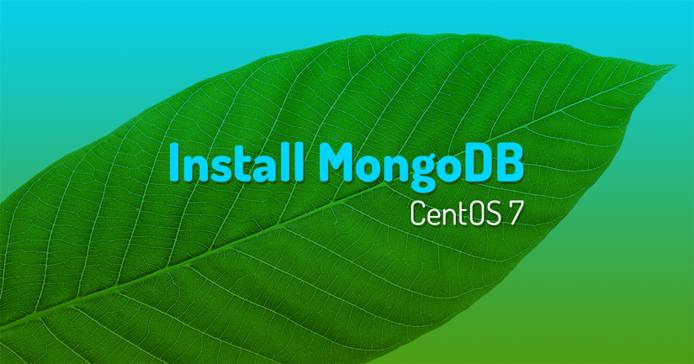Product docs and API reference are now on Akamai TechDocs.
Search product docs.
Search for “” in product docs.
Search API reference.
Search for “” in API reference.
Search Results
results matching
results
No Results
Filters
Installing MongoDB on CentOS 7
- Ubuntu 20.04
- Deprecated guides:
- Ubuntu 16.04
Traducciones al EspañolEstamos traduciendo nuestros guías y tutoriales al Español. Es posible que usted esté viendo una traducción generada automáticamente. Estamos trabajando con traductores profesionales para verificar las traducciones de nuestro sitio web. Este proyecto es un trabajo en curso.
In this MongoDB tutorial, we explain how to install the database on CentOS 7, and then provide a short guide on some basic features and functions.



MongoDB is a database engine that provides access to non-relational, document-oriented databases. It is part of the growing NoSQL movement, along with databases like Redis and Cassandra (although there are vast differences among the many non-relational databases).
MongoDB seeks to provide an alternative to traditional relational database management systems (RDBMS). In addition to its schema-free design and scalable architecture, MongoDB provides a JSON output and specialized, language-specific bindings that make it particularly attractive for use in custom application development and rapid prototyping. MongoDB has been used in a number of large scale production deployments and is currently one of the most popular database engines across all systems.
Since MongoDB can require a significant amount of RAM, we recommend using a high memory Linode with this guide.
Before You Begin
Familiarize yourself with our Getting Started guide and complete the steps for setting your Linode’s hostname and timezone.
Complete the sections of our Securing Your Server to create a standard user account, harden SSH access and remove unnecessary network services.
Update your system:
sudo yum update
sudo. If you’re not familiar with the sudo command, you can check our
Users and Groups
guide.Add the MongoDB Repository
The most current stable version of MongoDB is 4.2 and, as of this writing, the default CentOS 7 repository does not contain a package for it. Instead, we’ll need to use the MongoDB repository.
Create a new file, /etc/yum.repos.d/mongodb-org-4.2.repo, so that you can install the latest release using yum. Add the following contents to the file:
- File: /etc/yum.repos.d/mongodb-org-4.2.repo
1 2 3 4 5 6[mongodb-org-4.2] name=MongoDB Repository baseurl=https://repo.mongodb.org/yum/redhat/$releasever/mongodb-org/4.2/x86_64/ gpgcheck=1 enabled=1 gpgkey=https://www.mongodb.org/static/pgp/server-4.2.asc
Install MongoDB
Now that the MongoDB repository has been added, we’re ready to install the latest stable version of MongoDB:
sudo yum install mongodb-org
This command installs mongodb-org, a meta-package that includes the following:
mongodb-org-server- The standard MongoDB daemon, and relevant init scripts and configurationsmongodb-org-mongos- The MongoDB Shard daemonmongodb-org-shell- The MongoDB shell, used to interact with MongoDB via the command linemongodb-org-tools- Contains a few basic tools to restore, import, and export data, as well as other diverse functions.
These packages provide a good base that will serve most use cases, and we recommend installing them all. However, if you want a more minified installation, you can selectively install packages from the above list rather than use the mongodb-org metapackage.
For more information on the installation process and options, refer to the official MongoDB installation tutorial .
Configure MongoDB
The configuration file for MongoDB is located at /etc/mongod.conf, and is written in YAML format. Most of the settings are well commented within the file. We’ve outlined the default options below:
systemLogspecifies the various logging options, explained below:destinationtells MongoDB whether to store the log output as a file or sysloglogAppendspecifies whether to append new entries to the end of an existing log when the daemon restarts (as opposed to creating a backup and starting a new log upon restarting)pathtells the daemon where to send its logging information (/var/log/mongodb/mongod.logby default)
storagespecifies the settings that tell MongoDB how to store data, which we’ll explain below:dbPathindicates where the database files will be stored (/var/lib/mongoby default)journal.enabledenables or disables the journal, which ensures that data files are recoverable
netspecifies the various network options, explained below:portis the port on which the MongoDB daemon will listenbindIPspecifies the IP addresses to which MongoDB binds, so it can listen for connections from other applications
These are only a few basic configuration options that are set by default.
We strongly recommend uncommenting the security section and adding the following:
- File: /etc/mongod.conf
1 2security: authorization: enabled
The authorization option enables role-based access control
for your databases. If no value is specified, any user will have the ability to modify any database. We’ll explain how to create database users and set their permissions later in this guide.
For more information on how to customize these and other values in your configuration file, refer to the official MongoDB configuration tutorial .
After making changes to the MongoDB configuration file, restart the service as shown in the following section.
Increase User Limits
Issue the following commands to increase your open file and process limits for MongoDB:
echo "mongod soft nofiles 64000" >> /etc/security/limits.conf
echo "mongod soft nproc 64000" >> /etc/security/limits.conf
These are the recommended settings, but you may need to adjust them depending upon your individual usage. See the MongoDB Documentation for more information.
Start and Stop MongoDB
To start, restart, or stop the MongoDB service, issue the appropriate command from the following:
sudo systemctl start mongod
sudo systemctl restart mongod
sudo systemctl stop mongod
You can also enable MongoDB to start on boot:
sudo systemctl enable mongod
Create Database Users
If you enabled role-based access control in the Configure MongoDB section, create a user administrator with credentials for use on the database:
Open the
mongoshell:mongoBy default, MongoDB connects to a database called
test. Before adding any users, create a database to store user data for authentication:use adminUse the following command to create an administrative user with the ability to create other users on any database. For better security, change the values
mongo-adminandpassword:db.createUser({user: "mongo-admin", pwd: "password", roles:[{role: "userAdminAnyDatabase", db: "admin"}]})Keep these credentials in a safe place for future reference. The output will display all the information written to the database except the password:
Successfully added user: { "user" : "mongo-admin", "roles" : [ { "role" : "userAdminAnyDatabase", "db" : "admin" } ] }Exit the mongo shell:
quit()Test your connection to MongoDB with the credentials created in Step 3, using the
admindatabase for authentication:mongo -u mongo-admin -p --authenticationDatabase adminThe
-u,-p, and--authenticationDatabaseoptions in the above command are required in order to authenticate connections to the shell. Without authentication, the MongoDB shell can be accessed but will not allow connections to databases.The
mongo-adminuser created in Step 3 is purely administrative based on the roles specified. It is defined as an administrator of user for all databases but does not have any database permissions itself. You may use it to create additional users and define their roles. If you are using multiple applications with MongoDB, set up different users with custom permissions for their corresponding databases.As the
mongo-adminuser, create a new database to store regular user data for authentication. The following example calls this databaseuser-data:use user-dataPermissions for different databases are handled in separate
rolesobjects. This example creates the user,example-user, with read-only permissions for theuser-datadatabase and has read and write permissions for theexampleDBdatabase that we’ll create in the Manage Data and Collections section below.Create a new, non-administrative user to enter test data. Change both
example-userandpasswordto something relevant and secure:db.createUser({user: "example-user", pwd: "password", roles:[{role: "read", db: "user-data"}, {role:"readWrite", db: "exampleDB"}]})To create additional users, repeat Steps 6 and 7 as the administrative user, creating new usernames, passwords and roles by substituting the appropriate values.
Exit the mongo shell:
quit()
For more information on access control and user management, as well as other tips on securing your databases, refer to the MongoDB Security Documentation .
Manage Data and Collections
Much of MongoDB’s popularity comes from its ease of integration. Interactions with databases are done via JavaScript methods, but drivers for other languages are available. This section will demonstrate a few basic features, but we encourage you to do further research based on your specific use case.
Open the MongoDB shell using the
example-userwe created above:mongo -u example-user -p --authenticationDatabase user-dataCreate a new database. This example calls it
exampleDB:use exampleDBMake sure that this database name corresponds with the one for which the user has read and write permissions (we added these permissions in Step 7 of the previous section).
To show the name of the current working database, run the
dbcommand.Create a new collection called
exampleCollection:db.createCollection("exampleCollection", {capped: false})If you’re not familiar with MongoDB terminology, you can think of a collection as analogous to a table in a relational database management system. For more information on creating new collections, see the MongoDB documentation on the db.createCollection() method .
Note Collection names should not include certain punctuation such as hyphens. However, exceptions may not be raised until you attempt to use or modify the collection. For more information, refer to MongoDB’s naming restrictions .Create sample data for entry into the test database. MongoDB accepts input as documents in the form of JSON objects such as those below. The
aandbvariables are used to simplify entry; objects can be inserted directly via functions as well.var a = { name : "John Doe", attributes: { age : 30, address : "123 Main St", phone : 8675309 }} var b = { name : "Jane Doe", attributes: { age : 29, address : "321 Main Rd", favorites : { food : "Spaghetti", animal : "Dog" } }}Note that documents inserted into a collection need not have the same schema, which is one of many benefits of using a NoSQL database.
Insert the data into
exampleCollection, using theinsertmethod:db.exampleCollection.insert(a) db.exampleCollection.insert(b)The output for each of these operations will show the number of objects successfully written to the current working database:
WriteResult({ "nInserted" : 1 })Confirm that the
exampleCollectioncollection was properly created:show collectionsThe output will list all collections containing data within the current working database:
exampleCollectionView unfiltered data in the
exampleCollectioncollection using thefindmethod. This returns up to the first 20 documents in a collection, if a query is not passed:db.exampleCollection.find()The output will resemble the following:
{ "_id" : ObjectId("571a3e7507d0fcd78baef08f"), "name" : "John Doe" } { "_id" : ObjectId("571a3e8707d0fcd78baef090"), "age" : 30 }You may notice the objects we entered are preceded by
_idkeys andObjectIdvalues. These are unique indexes generated by MongoDB when an_idvalue is not explicitly defined.ObjectIdvalues can be used as primary keys when entering queries, although for ease of use, you may wish to create your own index as you would with any other database system.The
findmethod can also be used to search for a specific document or field by entering a search term parameter (in the form of an object) rather than leaving it empty. For example:db.exampleCollection.find({"name" : "John Doe"})Running the command above returns a list of documents containing the
{"name" : "John Doe"}object.
Additional MongoDB Functionality
As noted above, MongoDB has an available collection of language-specific drivers that can be used to interact with your databases from within non-JavaScript applications. One advantage these drivers provide is the ability to allow applications written in different languages to use the same database without the strict need for an object data mapper (ODM). If you do want to use an object data mapper, however, many well-supported ODMs are available.
The mongodb-org-tools package we installed also includes several other tools such as mongodump and mongorestore for creating and restoring backups and snapshots, as well as mongoimport and mongoexport for importing and exporting content from extended JSON, or supported CSV or TSV files.
To view the available options or how to use a particular method, append .help() to the end of your commands. For example, to see a list of options for the find method in Step 6 of Manage Data and Collections
:
db.exampleCollection.find().help()
More Information
You may wish to consult the following resources for additional information on this topic. While these are provided in the hope that they will be useful, please note that we cannot vouch for the accuracy or timeliness of externally hosted materials.
This page was originally published on

